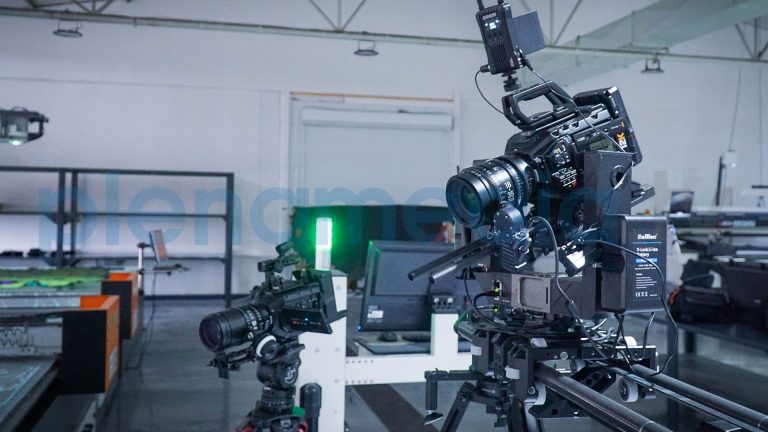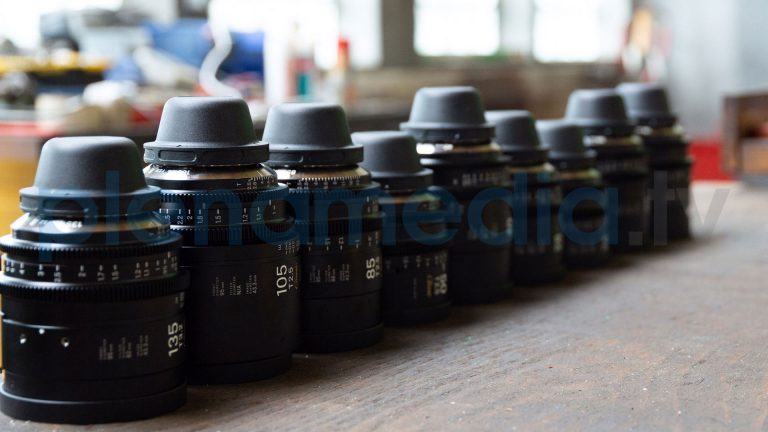KEY GREEN SCREEN FACTS IN A NUTSHELL
Chroma keying – separation of the subject and the background. Thanks to modern software, two different image sources can appear as a single image in a video. The example above shows the technique used in plenamedia.tv’s 2020 Christmas card.
Background colour – blue or green are the standard background colours used. Known as blue screen or green screen.
Image replacement – it is very important that the foreground image stands out clearly from the background image. The background image is replaced using modern software. This technique is also used for producing weather forecasts, for example.
Lighting – to achieve these special effects, it is vital that the background is lit without any shadows.
WHAT’S THE DIFFERENCE BETWEEN GREEN SCREEN, BLUE SCREEN AND CHROMA KEY?
All three terms describe the same digitally generated process. An object in a product film, for example, or a person being interviewed is “punched out” from a blue or green background – the “chroma keying” process.

In this video, our aim was to produce an atmospheric Christmas film showing a crackling fireplace with snow falling in the background. Although we could theoretically have shot the film in a mountain setting, this would have been costly and time-consuming. It was easier to shoot in front of a green screen using state-of-the-art cameras and lenses.
HOW DOES GREEN SCREEN / BLUE SCREEN TECHNOLOGY WORK?
The film and video-editing program is given the command to remove the colour blue or green from the recording and replace these areas with a new background.
It is important that the object to be replaced is monochromatic (either blue or green) and that the colours blue or green do not appear on the object or person being filmed.
Imagine, for instance, that you want to be interviewed in a dark-blue suit standing in front of a monument by the sea. In this case, the background used for the video recording should be green instead of blue.
This inexpensive technique can be used in the production of videos of any type.
IS IT BETTER TO USE GREEN SCREEN OR BLUE SCREEN TECHNOLOGY WHEN PRODUCING A FILM?
The reason for choosing a blue or green background is simple: these colours contrast most strongly with human skin tones and therefore represent the most suitable background colours. The person in the foreground therefore stands out clearly from the background – provided that the right lighting is in place. By defining the foreground and background, the video editing software makes the background fade away.
Previously, blue was the most common background colour selected. Nowadays, a green screen is favoured as the colour blue generally requires stronger illumination. However, green has one important disadvantage, in that it reflects the light falling on to it more than twice as strongly as a blue screen. If, then, the resulting reflections fall on the subject in the foreground, the software struggles to distinguish the foreground from the background and then blanks out part of the foreground image. It is vital, however, that no foreground colours appear in the background. For this reason, it is important to consider the colour of the subject’s clothing before opting for either green screen or blue screen.
WHY IS THE CORRECT LIGHTING SO IMPORTANT?
For our work, we use chroma key effects in promotional films, product films, commercials, interviews and virtual invitations. Additional realistic effects can also be created using 3D animation techniques. However, these are added on the computer after filming has taken place.
It is best if standard colours are used such as “Chroma Green” or “Chroma Blue”. These colours are standardised and designed to work with the software. Even with sub-optimal lighting, the computer recognises what it has to do.
The background needs to be lit at a constant level of brightness. It is important that any shadows are avoided. LED lamps should be used as light sources.
If the foreground casts shadows on the background or if the background reflects light on the object in the foreground, an unclean image is created. Any resulting colour spots are removed by the software during the chroma keying process. The aim must be to have a uniformly illuminated background when filming. It is therefore important to ensure that sufficient time is taken to set up the lighting.
plenamedia.tv – your professional partner in creatively implementing your ideas, planning and designing high-quality video projects for your company using state-of-the-art cameras of up to 12K resolution and green screen/blue screen technology.
plenamedia.tv: North Rhine-Westphalia, Cologne, Düsseldorf, Dortmund, Bonn, Leverkusen, Mönchengladbach, Aachen, Münster, Bochum, Siegen, Wuppertal, Duisburg, Mönchengladbach, Oberhausen, Gummersbach, Paderborn, Troisdorf, Gelsenkirchen, Recklinghausen, Remscheid, Bielefeld, Germany and Europe.



